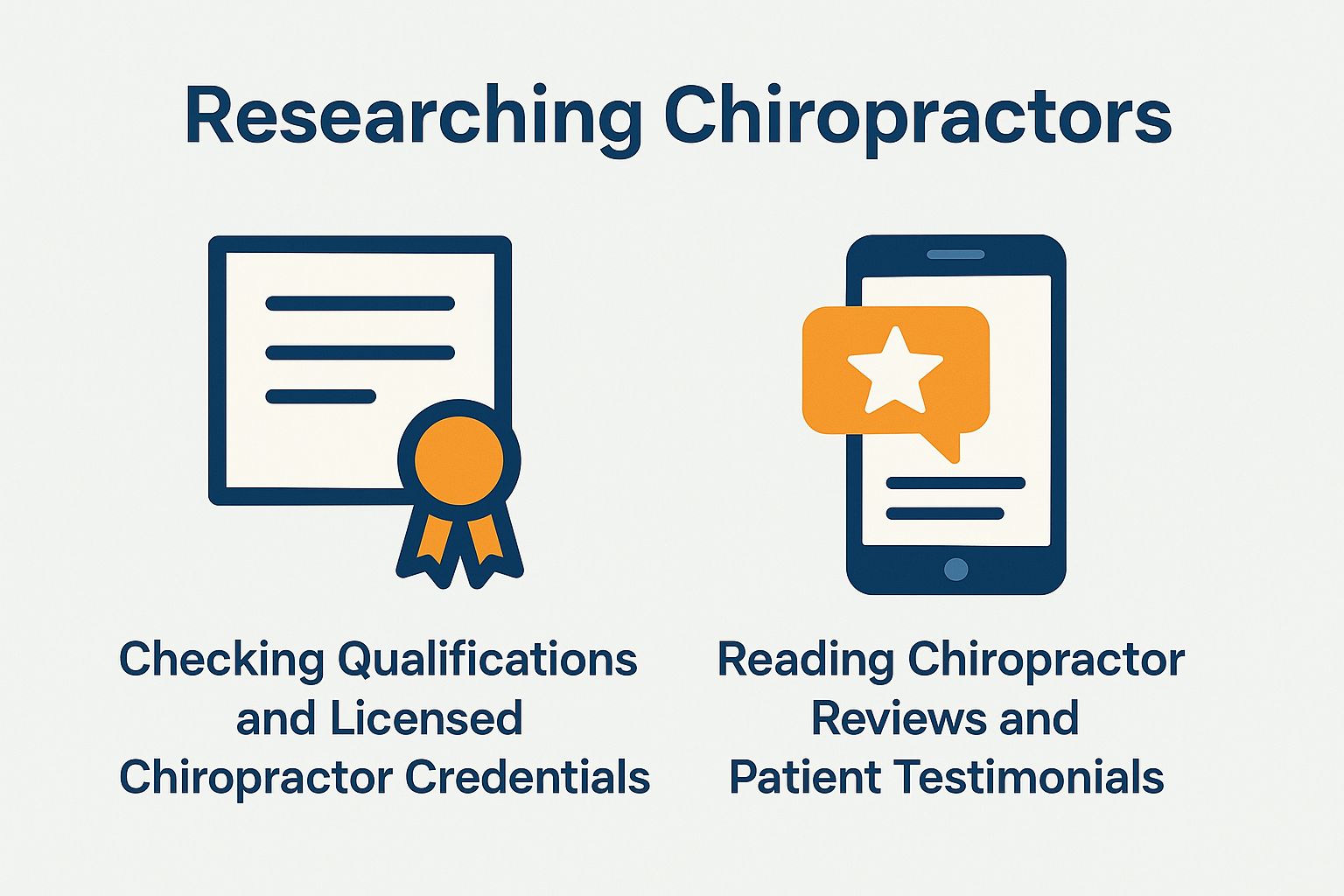
Choosing the right chiropractor can significantly impact your health and well-being, yet many find the process of finding chiropractor options daunting. With numerous practitioners available, understanding chiropractic care and identifying your specific needs is crucial. This guide will explore essential factors such as common conditions treated, evaluating chiropractic techniques, and what to expect during your first visit. Equip yourself with the knowledge needed to make an informed decision and embark on a path toward improved health.
Understanding Chiropractic Care and Holistic Health
Chiropractic care is centered on the diagnosis and treatment of musculoskeletal disorders, with a particular emphasis on conditions affecting the spine, spine alignment, and overall musculoskeletal health.
The primary objective is to promote holistic wellness and provide effective pain relief and back pain relief.

What is Chiropractic?
Chiropractic is a healthcare discipline that emphasizes the intricate relationship between the body’s structure, particularly the spine, and its function, which significantly impacts overall health. Practitioners in this field focus on diagnosing and treating mechanical disorders of the musculoskeletal system, with particular attention to spinal misalignments that may affect nerve function and overall well-being.
With over 35 million Americans seeking chiropractic treatment annually, this approach has gained widespread acceptance as an effective method for pain relief, particularly in cases of back pain, headaches, and joint issues.
Commonly employed techniques include spinal adjustments, massage, and exercise therapy, which provide patients with practical strategies to enhance mobility and improve overall health.
Common Conditions Treated and Chiropractic Benefits
Chiropractors frequently address conditions such as back pain, which affects approximately 80% of patients, as well as neck pain, joint pain, and sports-related injuries. They employ a variety of non-invasive techniques to facilitate treatment.
One such technique is spinal manipulation, which has been demonstrated to reduce symptoms of chronic back pain by as much as 50%. Additional methods include soft tissue therapy, which aims to alleviate muscle tension and enhance mobility in the affected areas.
The use of tools such as myofascial release can further complement these adjustments, promoting recovery from injuries. Chiropractors often prescribe exercise regimens tailored to strengthen specific muscle groups, thereby aiding in the prevention of future complications.
By integrating these approaches, patients can experience lasting pain relief and improved overall functional health.
If you are looking for a chiropractor in Jupiter, then Nordik is such a great option. Their location is below…
Identifying Your Needs
A comprehensive understanding of your specific health concerns is essential for selecting the appropriate chiropractic care that is tailored to your individual needs and treatment objectives.

Assessing Your Symptoms and Chiropractic Consultation
Commence by meticulously documenting your symptoms, including the location of pain, its intensity (on a scale of 1-10), and its duration, to facilitate a comprehensive initial assessment.
Subsequently, evaluate your symptoms utilizing the following checklist:
- Is the pain constant or intermittent?
- Does any specific activity exacerbate the pain?
- Have you observed any accompanying symptoms, such as swelling or redness?
It is advisable to track your symptoms over time to identify potential patterns-consider employing a straightforward application such as MyPainDiary to record daily observations. This information can prove invaluable during discussions with healthcare professionals, as it aids in identifying triggers and developing effective treatment plans.
Determining Treatment Goals
Establishing clear treatment goals can significantly enhance the efficacy of chiropractic care, facilitating the alignment of expectations between the patient and the chiropractor.
For instance, a patient may set a goal to reduce lower back pain by 70% within a three-month period. To achieve this, it is advisable to document specific metrics for monitoring progress, such as pain levels assessed on a scale of 1 to 10, the frequency of pain episodes, and the impact of these pain episodes on daily activities.
Utilizing a structured template, one might outline the goals as follows:
- Goal: Achieve a 70% reduction in pain within three months
- Metrics: Daily pain score
- Weekly activity log
Regular check-ins with the chiropractor are essential to ensure progress is being made and to collaboratively make any necessary adjustments to the treatment plan.
Researching Chiropractors
Comprehensive research is imperative for identifying a qualified chiropractor who can address your specific health needs and align with your treatment objectives.

Checking Qualifications and Licensed Chiropractor Credentials
It is essential to verify that your chiropractor possesses a Doctor of Chiropractic (D.C.) degree and is licensed by the chiropractic board in your state. This information can be confirmed through the National Board of Chiropractic Examiners (NBCE).
To initiate this process, visit the NBCE website and access their verification portal. Here, you can input your chiropractor’s details to confirm their qualifications.
Subsequently, consult your state chiropractic board’s website for additional requirements and to ensure that their license is current.
It is also advisable to inquire about any specialty certifications, such as sports chiropractic, which typically necessitate further training and ongoing education. Such certifications not only enhance the chiropractor’s credibility but may also signify a greater commitment to specific areas of care.
Reading Chiropractor Reviews and Patient Testimonials
Patient reviews and testimonials serve as valuable resources for assessing a chiropractor’s treatment effectiveness and overall patient satisfaction, thereby facilitating an knowledge-based decision making process and understanding chiropractic modalities.
To conduct a thorough analysis of these reviews, it is advisable to utilize reputable platforms such as Healthgrades, Yelp, or Google Reviews.
When evaluating feedback, it is essential to focus on key aspects such as the chiropractor’s communication style, treatment outcomes, and the overall office environment. It is beneficial to identify recurring themes within the reviews rather than concentrating on isolated complaints. For example, if several reviews highlight a positive experience with a particular treatment approach, it may indicate a notable strength of the practice.
Furthermore, prioritizing recent testimonials is crucial to ensure that the feedback accurately reflects the chiropractor’s current practices. By synthesizing this information, individuals can attain a clearer understanding of what to expect from a prospective chiropractor.
Evaluating Techniques and Specializations
Gaining an understanding of various chiropractic techniques and specializations is essential for selecting a practitioner whose methods align with your specific needs and conditions.

Common Chiropractic Techniques and Therapy Techniques
Common techniques utilized in treatment include spinal manipulations, diversified techniques, and soft tissue therapy, each offering distinct benefits tailored to specific conditions.
Additional methods, such as myofascial release, trigger point therapy, and kinesiology taping, also play significant roles in the overall treatment process, supporting chiropractic philosophy and holistic therapies.
Myofascial release is designed to alleviate tension in the fascia, resulting in improved mobility, with success rates reported in over 80% of patients. Trigger point therapy specifically targets muscle knots to relieve pain and enhance overall performance. Kinesiology taping, on the other hand, provides support to injured muscles and reduces swelling, with research indicating that it may accelerate healing time by up to 50%.
The selection of the appropriate technique often relies on the individual patient’s specific needs and the type of injury being addressed.
Finding a Specialist for Your Condition and Chiropractic Specialties
To identify a chiropractor who specializes in your specific condition, it is advisable to utilize resources such as the American Chiropractic Association’s directory or your local health network, ensuring chiropractic recommendations are tailored to your needs.
Begin by searching the American Chiropractic Association’s online directory, filtering the results based on your particular condition, such as lower back pain or sports-related injuries. Additionally, reach out to local health networks for referrals, and consider asking your general practitioner for recommendations that are aligned with your specific needs.
When contacting prospective chiropractors, it is essential to inquire about their experience with your particular condition and the treatment methods they utilize, such as spinal adjustments or physical therapy.
This approach will ensure that you make an informed decision tailored to your health requirements.
Consultation and First Visit with a Local Chiropractor
The initial visit to a chiropractor is essential for formulating an effective treatment plan. Familiarizing oneself with what to expect during this appointment can alleviate any anxiety that may arise.

What to Expect During the Consultation and Appointment Scheduling
During the consultation, one can anticipate a comprehensive discussion regarding their medical history, symptoms, and a physical examination to evaluate specific needs. The chiropractor may conduct particular tests, including range-of-motion assessments, posture evaluations, and neurological examinations, to identify any irregularities. Additionally, palpation techniques may be employed to pinpoint areas of tension or discomfort.
To maximize the effectiveness of the appointment, it is advisable to bring a checklist of essential items, which should include:
- medical records for neck pain treatment
- a list of current medications for chiropractic services
- any relevant imaging, such as X-rays, for injury rehabilitation
This information enables the chiropractor to develop a customized treatment plan tailored to the individual’s unique circumstances using evidence-based practice and chiropractic adjustments.
Questions to Ask Your Chiropractor Regarding Their Chiropractic Education and Expertise
It is advisable to prepare questions for your chiropractor to ensure alignment regarding treatment methods and expectations. A pertinent question to consider is, “What is your approach to pain management?”
Additionally, you may wish to inquire, “What techniques do you commonly use, and why?” This question will provide insight into their methodology and communication skills.
It is important to discuss the anticipated duration of treatment by asking, “How long until I should see improvement in spinal health and body mechanics?” This inquiry will help set realistic expectations.
Furthermore, asking, “What types of conditions do you specialize in as a rehabilitation specialist?” will allow you to evaluate their expertise related to your specific issue.
Lastly, it is beneficial to understand the integration of other therapies by posing the question, “Do you collaborate with other healthcare providers for a multidisciplinary approach?” Clear communication in this regard fosters a productive therapeutic relationship.
Making Your Decision: Evaluating Your Chiropractor Experience and Qualifications
Upon gathering all necessary information, one should make a well-informed decision that aligns with their health goals and needs, taking into account both personal and logistical factors such as insurance coverage and chiropractor qualifications.

Trust Your Instincts and Evaluate Communication Skills
Trusting one’s instincts regarding a trusted chiropractor can significantly influence both comfort and the overall success of treatment.
When assessing a chiropractor, it is important to consider their communication style. During the initial consultation, one should pay close attention to how the chiropractor listens to concerns and articulates their treatment plan.
It is essential to feel acknowledged; for example, when discussing chronic pain, a responsive chiropractor will tailor their approach to the individual rather than providing vague, generic treatments.
Additionally, it is advisable to verify their credentials and examine patient reviews online. Platforms such as Healthgrades or Yelp can offer valuable insights into the experiences of others. This thorough vetting process will assist in identifying a chiropractor who not only meets physical needs but also aligns with personal comfort levels.
Considering Logistics and Costs for Chiropractic Clinic Visits
It is essential to evaluate logistical factors such as location, appointment availability, and costs, including health insurance coverage, to prevent future complications.
Begin by identifying a chiropractor near me located within a 10-mile radius of your residence or workplace to ensure ease of access.
Assess online reviews to gain insights into appointment availability, chiropractor directory listings, and patient experiences.
Concerning costs, the average chiropractic visit typically ranges from $60 to $100, with most insurance plans covering a portion of the expenses, generally between 50% and 80% for chiropractic tools and patient care.
Contacting your insurance provider in advance can provide clarity on coverage specifics for chiropractic services, thereby minimizing the risk of unexpected expenses.
Additionally, some chiropractic practices offer payment plans for patients without insurance, enhancing accessibility to care for emergency chiropractor situations and sports injury recovery.
